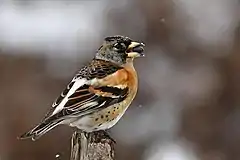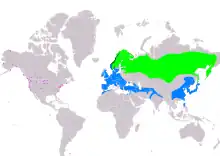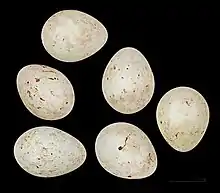Brambling
The brambling (Fringilla montifringilla) is a small passerine bird in the finch family Fringillidae. It has also been called the cock o' the north and the mountain finch. It is widespread and migratory, often seen in very large flocks.
| Brambling | |
|---|---|
 | |
| Male in Poland | |
.jpg.webp) | |
| Female in England | |
| Scientific classification | |
| Domain: | Eukaryota |
| Kingdom: | Animalia |
| Phylum: | Chordata |
| Clade: | Dinosauria |
| Class: | Aves |
| Order: | Passeriformes |
| Family: | Fringillidae |
| Subfamily: | Fringillinae |
| Genus: | Fringilla |
| Species: | F. montifringilla |
| Binomial name | |
| Fringilla montifringilla | |
 | |
| Range of F. montifringilla Breeding Resident Non-breeding Vagrant (seasonality uncertain) | |
Taxonomy
In 1758 Linnaeus included the species in the 10th edition of his Systema Naturae under its current binomial name, Fringilla montifringilla.[2][3] Montifringilla is from Latin mons, montis mountain and fringilla finch.[4] The English name "bramlyng" was used in 1544 by the English naturalist William Turner but later in the 16th century the current spelling "brambling" was used.[5][6][7] The etymology of the name is uncertain as the bird is not associated with the bramble or common blackberry Rubus fruticosus.[8]
Description
The brambling is similar in size and shape to a common chaffinch. Breeding-plumaged male bramblings are very distinctive, with a black head, dark upperparts, orange breast and white belly. Females and younger birds are less distinct, and more similar in appearance to some chaffinches. In all plumages, however, bramblings differs from chaffinches in a number of features:
- the brambling has a white rump, whereas that of the common chaffinch is grey-green;
- the breast is orange, contrasting with a white belly, on the brambling, whereas on the common chaffinch, the underparts are more uniformly coloured (pink or buff);
- the brambling's scapular feathers are orange, whereas the common chaffinch's are grey or grey-brown;
- the flanks are dark-spotted on the brambling, plain on the common chaffinch;
- bramblings lack the white outer tail feathers of common chaffinches.
An additional difference for all plumages except breeding-plumaged males is the bill colour - yellow in the brambling, dull pinkish in the common chaffinch (breeding-plumaged male bramblings have black bills, common chaffinches in the corresponding plumage have grey bills).[9]
Measurements:
Distribution and habitat
.jpg.webp)
This bird is widespread, in the breeding season, throughout the forests of northern Europe and east across the Palearctic. It is migratory, wintering in southern Europe, North Africa, northern India, northern Pakistan, China, and Japan.[1] It frequently strays into Alaska during migration and there are scattered records across the northern United States and southern Canada.[12] The global population of bramblings is about 100 to 200 million, with a decreasing trend.[1]
Open coniferous or birch woodland is favoured for breeding.[9]
Migration
This species is almost entirely migratory. In Europe, it forms large flocks in the winter, sometimes with thousands or even millions of birds in a single flock.[13][14] Such large gatherings occur especially if beech mast is abundant. Bramblings do not require beech mast in the winter, but winter flocks of bramblings will move until they find it. This may be an adaptation to avoid competition with the common chaffinch.[15]
Behaviour

Breeding
Bramblings first breed when they are one year old. The nest is usually placed high in a tree against the trunk. It is built by the female and consists of an outer layer which may contain lichen, grass, heather, cobwebs and strips of bark from birch or juniper trees. It is lined with feathers, soft grass and hair. The eggs are laid at daily intervals. The clutch usually contains 5-7 eggs. They range from light blue to dark olive-brown and have pink to rusty red spots and blotches. On average they measure 19.4 mm × 14.5 mm (0.76 in × 0.57 in) and have a calculated weight of 2.14 g (0.075 oz). Starting after the last egg has been laid, they are incubated by the female and hatch after 11-12 days. The young are fed and cared for by both parents and fledge after 13-14 days. Often only one brood is raised each year but two broods can be raised in northwest Russia.[16]
The nests can be predated by the carrion crow (Corvus corone) and the Siberian jay (Perisoreus infaustus). The nest are often parasitized by the common cuckoo (Cuculus canorus).[16]
References
- BirdLife International (2016). "Fringilla montifringilla". IUCN Red List of Threatened Species. 2016: e.T22720041A88203665. doi:10.2305/IUCN.UK.2016-3.RLTS.T22720041A88203665.en. Retrieved 12 November 2021.
- Paynter, Raymond A. Jnr., ed. (1968). Check-list of birds of the world, Volume 14. Cambridge, Massachusetts: Museum of Comparative Zoology. p. 206.
- Linnaeus, C. (1766). Systema Naturæ per regna tria naturae, secundum classes, ordines, genera, species, cum characteribus, differentiis, synonymis, locis, Volume 1 (in Latin) (10th ed.). Holmiae:Laurentii Salvii. p. 179.
- Jobling, James A (2010). The Helm Dictionary of Scientific Bird Names. London: Christopher Helm. p. 260. ISBN 978-1-4081-2501-4.
- Turner, William (1544). Avium praecipuarum, quarum apud Plinium et Aristotelem mentio est, brevis et succincta historia. [Cologne]: Johann Gymnicus. Pages are unnumbered.
- Turner, William (1903) [1544]. Turner on birds: a short and succinct history of the principal birds noticed by Pliny and Aristotle first published by Doctor William Turner, 1544 (in Latin and English). Translated by Evans, A.H. Cambridge: Cambridge University Press. p. 72.
- Veron, John (1575). "Montifrigilla". A Dictionary in Latine and English. London: H. Middleton for J. Harrison. Pages unnumbered.
- Lockwood, William Burley (1993) [1984]. The Oxford Dictionary of British Bird Names (2nd ed.). Oxford: Oxford University Press. p. 34. ISBN 978-0-19-866196-2.
- Mullarney, Killian; Svensson, Lars; Zetterstrom, Dan; Grant, Peter (1999). Collins Bird Guide. London: HarperCollins. ISBN 0-00-219728-6.
- Oiseaux.net. "Pinson du Nord - Fringilla montifringilla - Brambling". www.oiseaux.net. Retrieved 2020-09-29.
- "Brambling Bird Facts | Fringilla Montifringilla". The RSPB. Retrieved 2020-09-29.
- "eBird Brambling Species Map". Cornell Lab of Ornithology. Retrieved December 20, 2020.
- Jenni, L. (1987). "Mass concentrations of Bramblings Fringilla montifringilla in Europe 1900–1983: their dependence upon beech mast and the effect of snow-cover". Ornis Scandinavica. 18 (2): 84–94. doi:10.2307/3676843. JSTOR 3676843.
- Svensson, T. (2021). "A review of mass concentrations of Bramblings Fringilla montifringilla: implications for assessment of large numbers of birds". Ornis Svecica. 31: 44–67. arXiv:2010.08465. doi:10.34080/os.v31.22031.
- Newton, Ian (1973). Finches. The New Naturalist Library 55. New York: Taplinger. pp. 26–30. ISBN 0-8008-2720-1.
- Cramp 1994, p. 494.
- "RSPB: Brambling". Retrieved 7 January 2019.
Sources
- Cramp, Stanley; et al., eds. (1994). "Frigilla montifringilla Brambling". Handbook of the Birds of Europe the Middle East and North Africa. The Birds of the Western Palearctic. Vol. 8: Crows to Finches. Oxford: Oxford University Press. pp. 479–497. ISBN 978-0-19-854679-5.
External links
- Internet Bird Collection: Brambling
- Audio recordings from Xeno-canto
- Stamps Belgium, China, Taiwan
